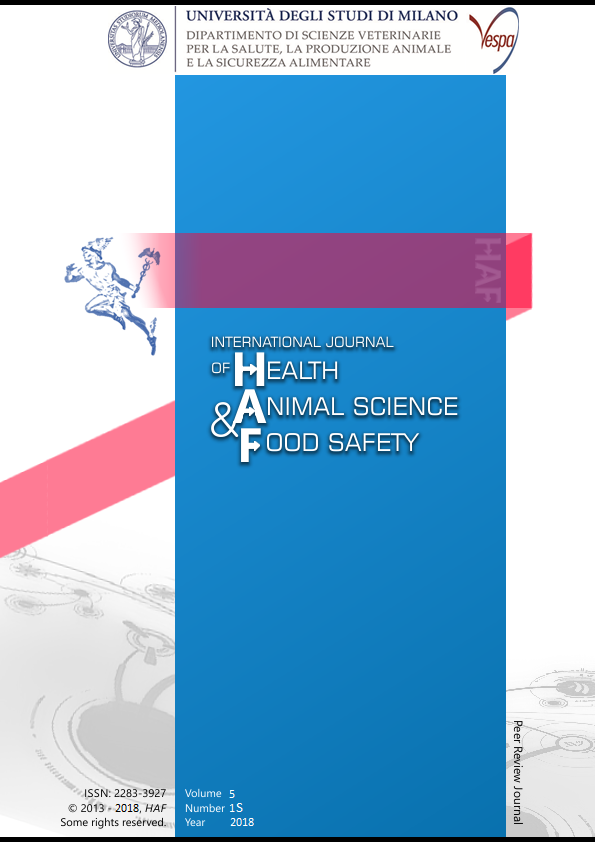Abstract
Recently, a scientific interest in exercise in water in equine athletes, both from training and rehabilitation purposes has been developed. Before an extended use of this practice in equine exercise physiology and medicine, the physiological adaptations to this type of exercise need to be elucidated.
Six horses were subjected to sessions of 40 minutes in water treadmill, with speeds of 5.5-6 km/h and with water at different depths: baseline (BL, exercise in water treadmill without water), and with the water at level of the metacarpophalangeal/metatarsophalangeal (MCPJ; MTPJ), tarsal (TJ) and stifle joints (SJ).
Hematology and blood lactate (LA) were measured before and after each session, and heart rate (HR) was monitored with a pulsometer. Horses also wore a portable gait analyzer, consisting of three orthogonal accelerometers, fixed at the sternum and at the sacrum, and the following parameters were measured: stride length (SL), stride frequency (SF), regularity (REG, measurement of the acceleration pattern similarity of successive strides in a period of time), symmetry (SYM, measurement of the similarities between left and right acceleration patterns), dorsoventral displacement (DVD, displacement of the gravity center in a dorsoventral direction), dorsoventral DVP, propulsion PP, mediolateral MLP and total power TP, representing the amount of acceleration and deceleration along the dorsoventral, longitudinal and lateral axes and the sum of the three powers respectively.
Significant changes in hematological parameters and in blood LA concentrations before and after each exercise session were not found. Blood LA concentrations after BL, MCPJ, TJ and SJ sessions reached mean values of 1.03±0.41, 1.05±0.28, 1.05±0.52 and 1.11±0.22 mmol/l respectively. HR increased significantly in the four sessions, with significant differences after exercise between BL (66.13±8.92 bpm), TJ (81.89±10.67 bpm) and SJ (81.13±14.68 bpm) levels. Further, significant differences were also found between exercise at the level of MCPJ (71.09±8.90 bpm) and TJ.
With the accelerometer fixed on the sternum, increased SL, DVD, DVP and TP together with a decreased SF was found with the water at the level of TJ, compared to the other water depths. With the accelerometer fixed on the sacrum, significant changes were not observed in SF between the different water depths. The highest values for SL, DVD, DVP, PP, MLP and TP were found with the water at the level of the TJ.
Our results reveal that exercise in WT, nevertheless of the water depth (at least until stifle joint), represents a mild aerobic exercise, with low HR and blood LA under the aerobic threshold of 2 mmol/l. However, this type of exercise leads to profound changes in locomotion, mainly in stride length and frequency and in muscle power, with the highest values with water depths at the tarsal and stifle joints. Consequently, the low cardiovascular and metabolic demands are expected to be of interest for the recovery of injured horses. Further, the important effects on locomotion characteristics reflect a relevant future use for both training and rehabilitating horses.
Riferimenti bibliografici
Becero, M., Saitua, A., Reguera, M., Castejón-Riber, C., Herrera, R., Muñoz, A. 2018. Ejercicio en treadmill acuático en la rehabilitación de un caballo con tendinopatía del flexor digital superficial. II Congreso de Veterinaria y Ciencia y Tecnología de los Alimentos.
Herrera, R., Saitua, A., Becero, M., Castejón-Riber, C., Muñoz, A. 2018. Longitud de tranco y desplazamiento dorsoventral del centro de gravedad en caballos ejercitados sobre diferentes superficies, treadmill terrestre y acuático. Congreso de la Asociación de Veterinarios Especialistas en Équidos.
Muñoz, A., Castejón-Riber, C., Riber, C., Esgueva, M., Méndez-Angulo, J., Mateo, S., Castejón, F. 2016. Cambios locomotores determinados mediante acelerometría en caballos ejercitados en treadmill acuático a diferentes profundidades de agua. XVII Congreso International de Medicina y Cirugía Equina.
Riber, C., Castejón-Riber, C., Esgueva, M., Méndez-Angulo, J.L., Castejón, F., Muñoz, A. 2016. Cambios cinemáticos beneficiosos para rehabilitación en caballos ejercitados en treadmill acuático. Congreso Internacional de la Sociedad Española de Cirugía Veterinaria SECIVE.
This work is licensed under a CC BY-SA 4.0 international

